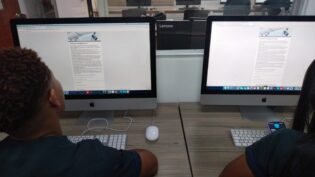Dynamic Tests for Assertive Formative Assessment
Published 20 September 2024

Photo by: pexels.com
This paper explores the use of generative artificial intelligences to create dynamic tests in formative assessments. Through personalized quizzes, immediate feedback is facilitated, allowing the teacher to adjust his or her teaching in real time. This innovative methodology improves students’ understanding, catering to their individual needs and fostering deeper and more meaningful learning.
Imagine for a moment the following scenario: a small group of five students, all around the teacher, who, behind him, has a large screen, where he shows them multiple choice questions, which they must answer in up to 25 seconds each.
What happened here? How does the teacher manage to have so many evaluations for small, personalized groups of students? Well, it seems that the secret lies in generative artificial intelligences.
Before starting the evaluation process, let’s remember that the students have already been aware of the contents, since, when working in the inverted classroom format, they previously, week by week, review the information sent in the LMS, in this case moodle, with which they have had recognition of the resources, be these videos, PDFs, internet documents, forums, etc., all of them sources, with which the students are nourished before the class session.
With this foreseen, the limited time of the meeting with the students is used to the maximum and in the most efficient way. This session begins with the teacher mentioning that, at the beginning of each class, dynamic tests are given, which are formative tests, with which the teacher verifies that the students have previously accessed the contents.
Since each group of students is divided into work teams, the teacher calls a representative for each team. This representative comes with his or her cell phone in hand and approaches the teacher’s space. In turn, the teacher has a screen to which he has connected his computer to visualize the content that will be available for the exam. In this way, a gathering of a few students around the teacher and a screen is already visualized, providing a very personalized attention at the time of the test.

For the arrangement of the test, the teacher does the following activity: in front of the students he takes the content of the subject to be evaluated, copies it and pastes it in the line of a generative artificial intelligence, either ChatGPT or Gemini, completing the prompt as follows: “based on the following text, generate a questionnaire of ten multiple-choice questions and place the answers at the end of it:”.
Once this is done and the prompt is launched, the AI generates the questions with the answers at the end. In addition, on the screen the teacher sets the timer to adjust 25 or 30 seconds for them to answer each one of them, which will go through them one by one, also, during that time, the teacher will read them as well as the answer options. The only thing the kids have to answer, on their cell phones, is a, b, c or d. In this way, the teacher goes through the ten questions of the test in a few minutes, while the students write down in any application, usually a note sheet.
At the end of the exam, the students give their cell phones to the teacher and he takes note of the answers given on the screen and compares them with those written down by the students in each of their cell phones and obtains the relevant evaluations.
At the end of this exercise, if he considers it necessary, the teacher calls a new group of students, whom he evaluates with another topic, applying the same protocol of use, taking advantage of artificial intelligence.
Throughout the application process, the process has been systematized and regulated, starting by identifying a specific topic that the students are learning. Next, an AI tool is used to create a bank of varied and adaptive questions. Based on this, customized quizzes are designed to fit each student’s level. During the class, students will answer these questions and, in real time, the AI evaluates their answers, providing immediate feedback and suggestions for improvement.
In the end, in an academic strategy by the university, called the MySelf tab, there has been the opportunity to apply and reveal this strategy for an assertive formative assessment process with students, promoting the following institutional result: dynamic quizzes with AI offer an innovative solution to the need to personalize learning. By tailoring questions and difficulty to each student, the challenge of teaching heterogeneous groups is overcome. In addition, the immediate and specific feedback provided by AI makes it possible to identify each student’s knowledge gaps and adjust teaching strategies in real time. In this way, understanding of concepts is improved and student motivation is increased, fostering deeper and more meaningful learning, students will be able to identify their strengths and weaknesses, while the teacher will be able to adjust his or her teaching to meet the individual needs of each student.



